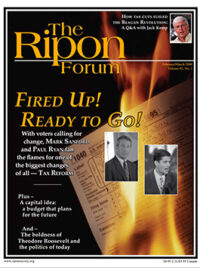The American health care system needs to embrace 21st century technology. This can begin now by dramatically increasing the number of prescriptions transmitted electronically.
Every year, over 3 billion prescriptions are filled in the United States, the majority of which are scribbled on a 3” by 5” note pad and handed to the patient to be brought to their local pharmacy. This is an antiquated model that has proven to be fatal on many occasions. Our health care system must utilize new technologies that will dramatically reduce costly and fatal errors and prove to be more convenient for both patients and physicians.
The stories of harmful drug interactions and medical errors impact over one million Americans annually, of which, over 7,000 prove fatal. The technology to significantly reduce these errors is available, but there has not been widespread application. The federal government can play a role in expediting a national transformation.
Our health care system must utilize new technologies that will dramatically reduce costly and fatal errors and prove to be more convenient for both patients and physicians.
The benefits of electronic prescribing are easy to understand for patients. In addition to the reduction in hazardous drug interactions, there are multiple health care and efficiency benefits to e-prescribing for all prescriptions. The obvious advantage is that electronically submitted prescriptions reduce the chances of filling errors resulting from difficult to read handwritten prescriptions, and transcription errors made when taking a prescriber’s oral prescription order via telephone.
Before a prescription is even submitted to a pharmacy of the patients choosing, the prescriber is able to perform an initial drug interaction review. This would allow the prescriber to be absolutely certain that the new drug being prescribed is not in conflict with a drug that the patient is already taking.
Furthermore, the utilization of electronic prescribing technology not only saves time for the physicians, but also the patients. Using this system, prescribers can transmit prescriptions so that they are already completed by the time the patient arrives at the pharmacy.
Many health care practitioners believe that the implementation of electronic prescribing technologies is vital to the future of our healthcare system. A 2006 study conducted by the Institute of Medicine, a Washington based research group, found that 85% of physicians think that e-prescribing is a good idea, with 81% and 65%, respectively, stating that it would reduce errors and save time. Despite the overwhelming support expressed for the adoption of electronic prescribing technologies, only 7% of those physicians who participated in this study utilized such technologies. The adoption of these new prescription processing protocols would allow physicians more time to do what they do best, provide care to their patients. The 2006 Institute of Medicine study further recommended that there be a nation-wide switch from handwritten prescriptions to electronic prescriptions by 2010.
The support is not only coming from the medical community but it has already become a popular policy goal with the consumer. In a survey completed in January 2008, nearly 70% of consumers approved requiring doctors to move towards electronic prescribing technology. It is clear that both doctors and patients understand that reducing paper and handwriting is an effective way to save lives and money.
E-prescribing is a necessary and constructive step to move our health care system into the 21st century.
I, and many of my Congressional colleagues, understand the immediate need to implement these new technologies. That is why, to try to save lives and eliminate adverse medical reactions due to preventable prescription errors, I introduced this past December the E-MEDS Act of 2007, which would create a gradual mandate with financial incentives for doctors to throw away the note pads. The legislation has broad, bipartisan support in the House. Senators Kerry and Ensign have introduced companion legislation in the Senate.
E-prescribing is a necessary and constructive step to move our health care system into the 21st century. While I am encouraged that Congress has already recognized the multiple health care and efficiency benefits of e-prescribing, we must continue to work tirelessly to see that this technology is implemented nationally.
Jon Porter represents the 3rd District of Nevada in the U.S. House of Representatives.





